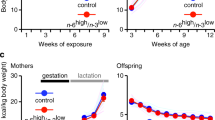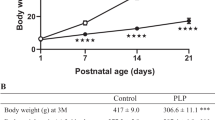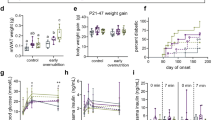Abstract
Background:
High multivitamin (10-fold AIN-93G, HV) diets fed during pregnancy to Wistar rats increase characteristics of metabolic syndrome in offspring when weaned to the recommended vitamin (RV) diet.
Objective:
To determine whether the effects of HV gestational diets on obesogenic phenotypes in the offspring arise as a consequence of altered hypothalamic control of feeding behavior and if their increased food intake could be prevented by feeding them HV or high folate (10-fold folate, HFol) diets.
Methods:
Male offspring of dams fed HV diet during pregnancy weaned to RV, HV or HFol diets were compared with those born to RV dams and weaned to RV diet for 29 weeks. Food intake over 72 h and body weight were measured bi-weekly and weekly, respectively. Glucose response to a glucose load was measured at 18 weeks post weaning. Hypothalamic gene expression of feeding-related neuropeptides including neuropeptide Y, pro-opiomelanocortin (POMC), insulin receptor, leptin receptor, brain-derived neurotrophic factor (BDNF), receptors for dopamine (DopaR1/2/5) and serotonin (SeroR1A/2A/2C), as well as global DNA methylation and brain and plasma folate concentrations were measured at 29 weeks post weaning.
Results:
HV or HFol pup diets increased brain and plasma folate concentrations and prevented the increase in food intake (5%, P=0.03), body weight (8%, P=0.0006) and glucose response to a glucose load (36%, P=0.02) found in those fed the RV diet. Expression of anorexigenic POMC (P=0.004) and BDNF (P=0.02) was higher, and DopaR1 was lower (P=0.06) in pups fed the HV diet. The HFol pup diet partially brought BDNF to the control level (P=0.02) and lowered SeroR2A (P=0.008). Expression of other genes was unaffected. Global DNA methylation was similar among the diet groups.
Conclusion:
The obesogenic phenotype in offspring from HV-fed dams is prevented by feeding HV or HFol pup diets, possibly due to post-weaning modulation of food intake regulatory mechanisms.
This is a preview of subscription content, access via your institution
Access options
Subscribe to this journal
Receive 12 print issues and online access
$259.00 per year
only $21.58 per issue
Buy this article
- Purchase on Springer Link
- Instant access to full article PDF
Prices may be subject to local taxes which are calculated during checkout






Similar content being viewed by others
References
Barker DJ, Gluckman PD, Godfrey KM, Harding JE, Owens JA, Robinson JS . Fetal nutrition and cardiovascular disease in adult life. Lancet 1993; 341: 938–941.
Hales CN, Barker DJ . Type 2 (non-insulin-dependent) diabetes mellitus: the thrifty phenotype hypothesis. Diabetologia 1992; 35: 595–601.
Fall CH, Yajnik CS, Rao S, Davies AA, Brown N, Farrant HJ . Micronutrients and fetal growth. J Nutr 2003; 133 (Suppl 2): 1747S–1756S.
Szeto IM, Aziz A, Das PJ, Taha AY, Okubo N, Reza-Lopez S et al. High multivitamin intake by Wistar rats during pregnancy results in increased food intake and components of the metabolic syndrome in male offspring. Am J Physiol Regul Integr Comp Physiol 2008; 295: R575–R582.
Szeto IM, Das PJ, Aziz A, Anderson GH . Multivitamin supplementation of Wistar rats during pregnancy accelerates the development of obesity in offspring fed an obesogenic diet. Int J Obes 2009; 33: 364–372.
Berthoud HR . Mind versus metabolism in the control of food intake and energy balance. Physiol Behav 2004; 81: 781–793.
Cripps RL, Martin-Gronert MS, Ozanne SE . Fetal and perinatal programming of appetite. Clin Sci 2005; 109: 1–11.
McMillen IC, Adam CL, Muhlhausler BS . Early origins of obesity: programming the appetite regulatory system. J Physiol 2005; 565 (Pt 1): 9–17.
Gluckman PD, Hanson MA . Living with the past: evolution, development, and patterns of disease. Science 2004; 305: 1733–1736.
Gluckman PD, Hanson MA, Spencer HG . Predictive adaptive responses and human evolution. Trends Ecol Evol 2005; 20: 527–533.
Dominguez-Salas P, Cox SE, Prentice AM, Hennig BJ, Moore SE . Maternal nutritional status, C(1) metabolism and offspring DNA methylation: a review of current evidence in human subjects. Proc Nutr Soc 2012; 71: 154–165.
Kim YI . Nutritional epigenetics: impact of folate deficiency on DNA methylation and colon cancer susceptibility. J Nutr 2005; 135: 2703–2709.
Reeves PG . Components of the AIN-93 diets as improvements in the AIN-76A diet. J Nutr 1997; 127: 838S–841S.
Glowinski J, Iversen LL . Regional studies of catecholamines in the rat brain. I. The disposition of [3H]norepinephrine, [3H]dopamine and [3H]dopa in various regions of the brain. J Neurochem 1966; 13: 655–669.
Livak KJ, Schmittgen TD . Analysis of relative gene expression data using real-time quantitative PCR and the 2(-Delta Delta C(T)) method. Methods 2001; 25: 402–408.
Molloy AM, Scott JM . Microbiological assay for serum, plasma, and red cell folate using cryopreserved, microtiter plate method. Methods Enzymol 1997; 281: 43–53.
Sie KK, Chen J, Sohn KJ, Croxford R, Thompson LU, Kim YI . Folic acid supplementation provided in utero and during lactation reduces the number of terminal end buds of the developing mammary glands in the offspring. Cancer Lett 2009; 280: 72–77.
Kotsopoulos J, Medline A, Renlund R, Sohn KJ, Martin R, Hwang SW et al. Effects of dietary folate on the development and progression of mammary tumors in rats. Carcinogenesis 2005; 26: 1603–1612.
Kotsopoulos J, Sohn KJ, Martin R, Choi M, Renlund R, McKerlie C et al. Dietary folate deficiency suppresses N-methyl-N-nitrosourea-induced mammary tumorigenesis in rats. Carcinogenesis 2003; 24: 937–944.
Fan W, Boston BA, Kesterson RA, Hruby VJ, Cone RD . Role of melanocortinergic neurons in feeding and the agouti obesity syndrome. Nature 1997; 385: 165–168.
Xu B, Goulding EH, Zang K, Cepoi D, Cone RD, Jones KR et al. Brain-derived neurotrophic factor regulates energy balance downstream of melanocortin-4 receptor. Nat Neurosci 2003; 6: 736–742.
Muhlhausler BS, Adam CL, McMillen IC . Maternal nutrition and the programming of obesity: The brain. Organogenesis 2008; 4: 144–152.
Muhlhausler BS, Adam CL, Findlay PA, Duffield JA, McMillen IC . Increased maternal nutrition alters development of the appetite-regulating network in the brain. FASEB J 2006; 20: 1257–1259.
Baskin DG, Wilcox BJ, Figlewicz DP, Dorsa DM . Insulin and insulin-like growth factors in the CNS. Trends Neurosci 1988; 11: 107–111.
Baskin DG, Breininger JF, Schwartz MW . Leptin receptor mRNA identifies a subpopulation of neuropeptide Y neurons activated by fasting in rat hypothalamus. Diabetes 1999; 48: 828–833.
Cheung CC, Clifton DK, Steiner RA . Proopiomelanocortin neurons are direct targets for leptin in the hypothalamus. Endocrinology 1997; 138: 4489–4492.
Meguid MM, Yang ZJ, Laviano A . Meal size and number: relationship to dopamine levels in the ventromedial hypothalamic nucleus. Am J Physiol 1997; 272 (Pt 2): R1925–R1930.
Meguid MM, Yang ZJ, Koseki M . Eating induced rise in LHA-dopamine correlates with meal size in normal and bulbectomized rats. Brain Res Bull 1995; 36: 487–490.
Page KC, Malik RE, Ripple JA, Anday EK . Maternal and postweaning diet interaction alters hypothalamic gene expression and modulates response to a high-fat diet in male offspring. Am J Physiol Regul Integr Comp Physiol 2009; 297: R1049–R1057.
Pelleymounter MA, Cullen MJ, Wellman CL . Characteristics of BDNF-induced weight loss. Exp Neurol 1995; 131: 229–238.
Lyons WE, Mamounas LA, Ricaurte GA, Coppola V, Reid SW, Bora SH et al. Brain-derived neurotrophic factor-deficient mice develop aggressiveness and hyperphagia in conjunction with brain serotonergic abnormalities. Proc Natl Acad Sci USA 1999; 96: 15239–15244.
Kernie SG, Liebl DJ, Parada LF . BDNF regulates eating behavior and locomotor activity in mice. EMBO J 2000; 19: 1290–1300.
Carone BR, Fauquier L, Habib N, Shea JM, Hart CE, Li R et al. Paternally induced transgenerational environmental reprogramming of metabolic gene expression in mammals. Cell 2010; 143: 1084–1096.
Mehedint MG, Niculescu MD, Craciunescu CN, Zeisel SH . Choline deficiency alters global histone methylation and epigenetic marking at the Re1 site of the calbindin 1 gene. FASEB J 2010; 24: 184–195.
Niculescu MD, Craciunescu CN, Zeisel SH . Dietary choline deficiency alters global and gene-specific DNA methylation in the developing hippocampus of mouse fetal brains. FASEB J 2006; 20: 43–49.
van Wijk N, Watkins CJ, Bohlke M, Maher TJ, Hageman RJ, Kamphuis PJ et al. Plasma choline concentration varies with different dietary levels of vitamins B6, B12 and folic acid in rats maintained on choline-adequate diets. Br J Nutr 2012; 107: 1408–1412.
Vucetic Z, Kimmel J, Reyes TM . Chronic high-fat diet drives postnatal epigenetic regulation of mu-opioid receptor in the brain. Neuropsychopharmacology 2011; 36: 1199–1206.
Acknowledgements
We thank the Canadian Institute of Health Research, Institute of Nutrition, Metabolism and Diabetes, Reference MOP-93624 for funding this research. Clara E. Cho is supported by the Natural Sciences and Engineering Research Council of Canada Postgraduate Scholarship, Diana Sánchez-Hernández and Sandra A Reza- López by the ConsejoNacional de Ciencia y Tecnologia (Mexico) and Pedro S.P. Huot by the Ontario Graduate Scholarship.
Author information
Authors and Affiliations
Corresponding author
Ethics declarations
Competing interests
The authors declare no conflict of interest.
Rights and permissions
About this article
Cite this article
Cho, C., Sánchez-Hernández, D., Reza-López, S. et al. Obesogenic phenotype of offspring of dams fed a high multivitamin diet is prevented by a post-weaning high multivitamin or high folate diet. Int J Obes 37, 1177–1182 (2013). https://doi.org/10.1038/ijo.2012.210
Received:
Revised:
Accepted:
Published:
Issue Date:
DOI: https://doi.org/10.1038/ijo.2012.210
Keywords
This article is cited by
-
Primary Pediatric Hypertension: Current Understanding and Emerging Concepts
Current Hypertension Reports (2017)



